

| ▲ Workshop |
07/05/13: Anders Wallin has made a great version of this using bolts to bring the pins together and a steel frame with Thorlabs posts to guide them. See his webpage on it here: http://www.anderswallin.net/2013/04/crimp-clamp-tool/.
A common issue/problem in vacuum systems is producing sealed-off devices. If the device is provided with a glass pump-out tube, the tube can be flame-sealed while under vacuum. Properly done, this probably provides the best possible seal. However, the procedure is a little bit tricky and the resulting seal is sometimes quite fragile (especially if it's done wrong!). Fortunately, it is possible to produce permanent seals on metal tubing (usually soft copper) by compressing the tubing between rounded pins until the tubing cold-welds together and breaks off. This is referred to as a "pinch-off".
Hand tools for doing this properly are very expensive because they have to be extremely precisely made in order to bring the two pins together exactly parallel and apply sufficient force to sever the tubing. I have a bench press for punching/stamping and whatnot, so I decided to try making a pair of dies for making pinch-offs. I managed found an excellent document describing how to use a manual pinch-off tool to seal copper tubing. It is available here from the University of Utah, or here as a backup on this site. The press tool shown here is based on the photos in that document.
The two pins are 1/8" diameter tungsten carbide from the shanks of broken PCB drills. They fit neatly into half-round slots in two cylindrical aluminium holders which are held in the bench-press tooling. The aluminium holders were originally simple cylindrical slugs, and the half-round slots were produced by clamping both slugs end-to-end in the milling vice and drilling an 1/8" hole right down the joining line between them. The holders are aligned in the bench press by removing one of the carbide pins and bringing the top holder down so the remaining pin locates both grooves so they are exactly parallel and in line.
The carbide pins are oiled to reduce friction when pressing. The copper tube is placed between the pins (the upper one stays in its holder with the stickiness of the oil) and the two pins brough together with the press. The tube collapses until resistance is felt - further pressure is now applied slowly to cold-weld the tubing walls together. Finally, when the two pins are together, the tubing separates and the seal is complete. The finished edge is very delicate and should be protected with a blob of epoxy or tape.
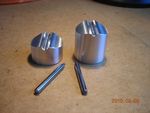 Tooling showing holders and carbide pins |
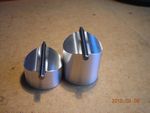 Pins placed in holders |
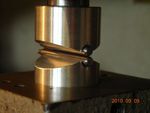 Holders mounted in bench press |
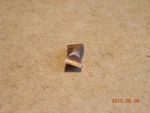 Example of pinch-off |
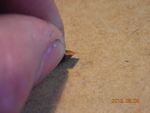 Edge-on view |
Note that there are cheap tools available advertising themselves as pinch-off tools for copper pipe. These are usually intended for the HVAC market and are used to shut off refrigeration piping when working on the system. These tools only compress the pipe shut, they do not sever it. In order for a good vacuum-tight seal to be made, the tubing must be completely severed to ensure cold-welding of the metal.
| ▲ Workshop |